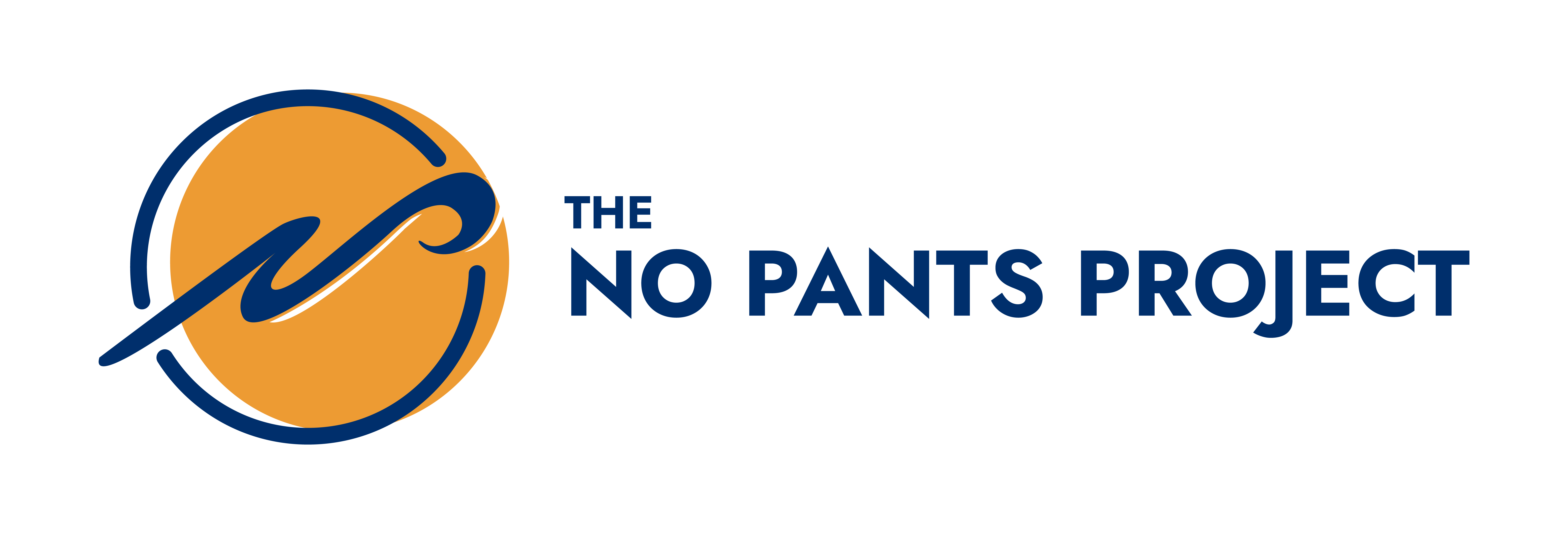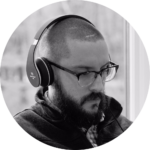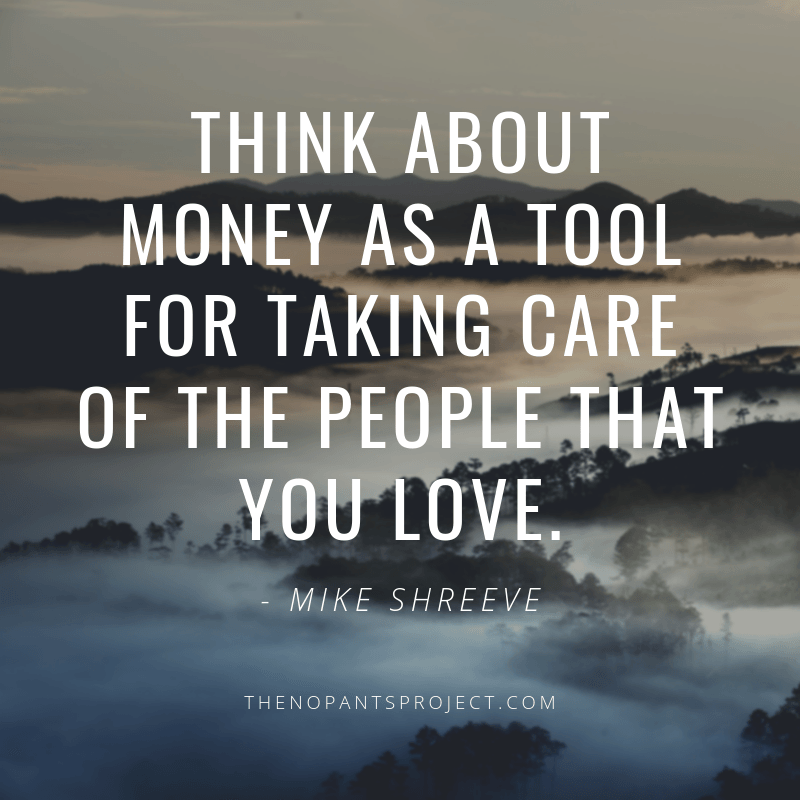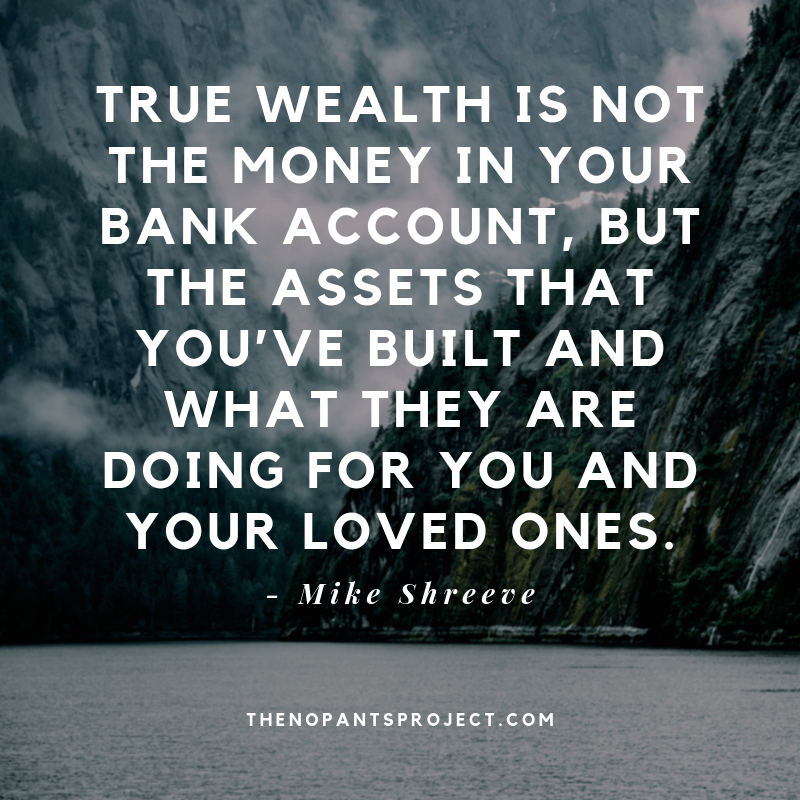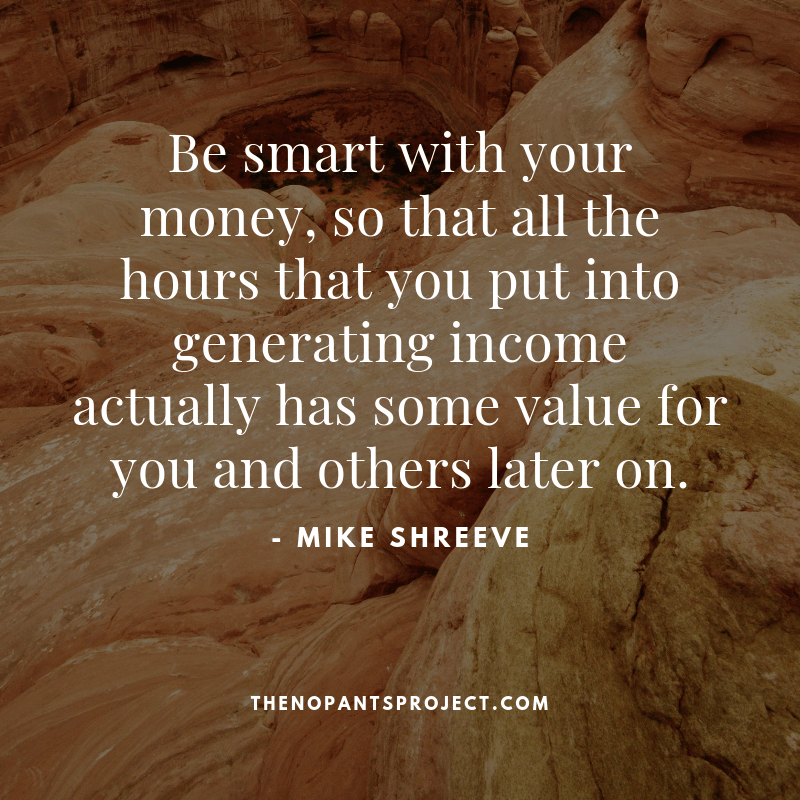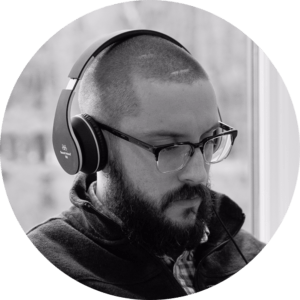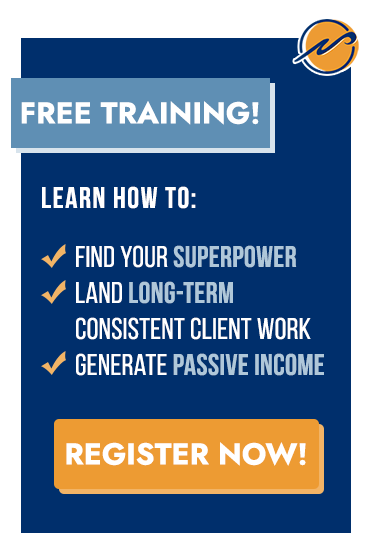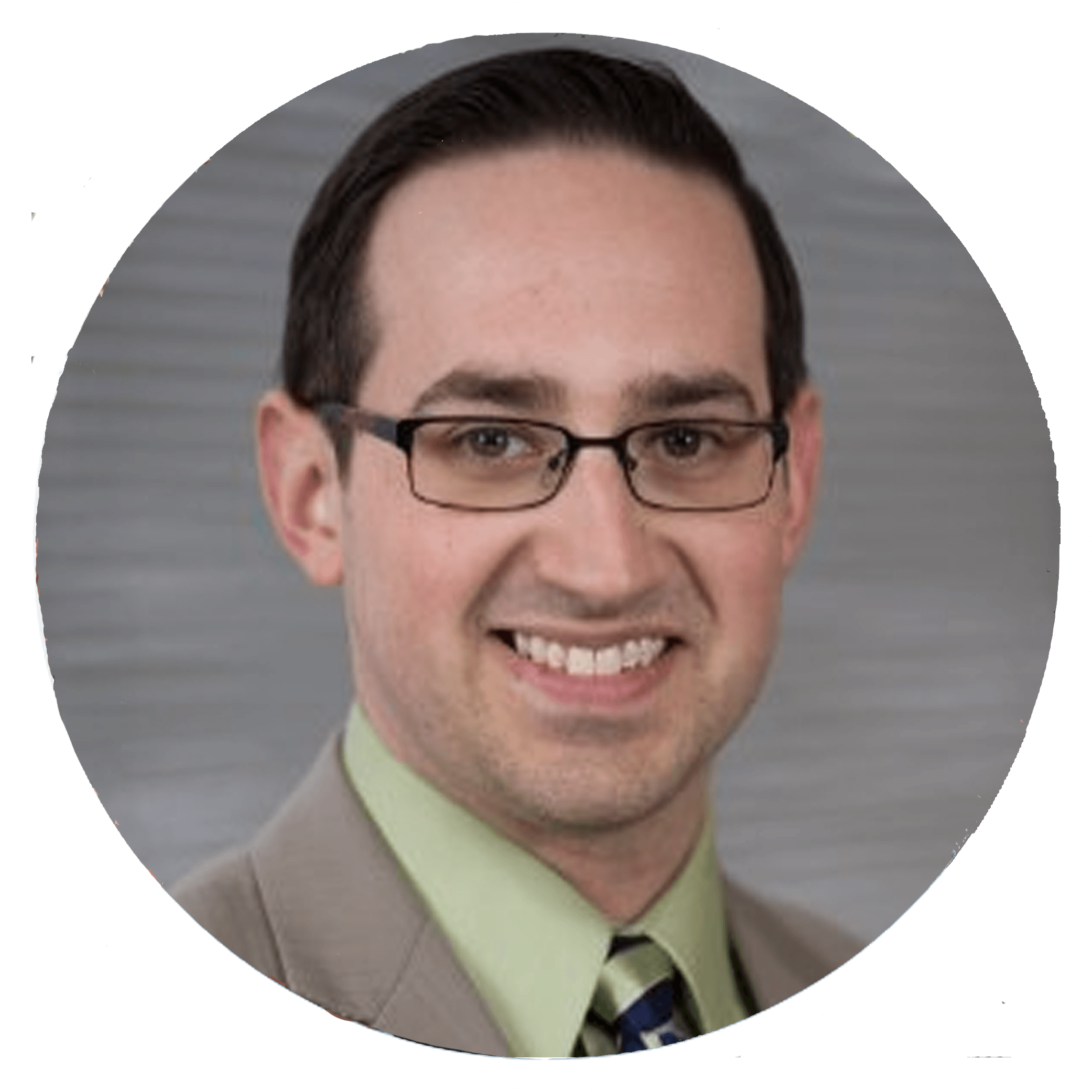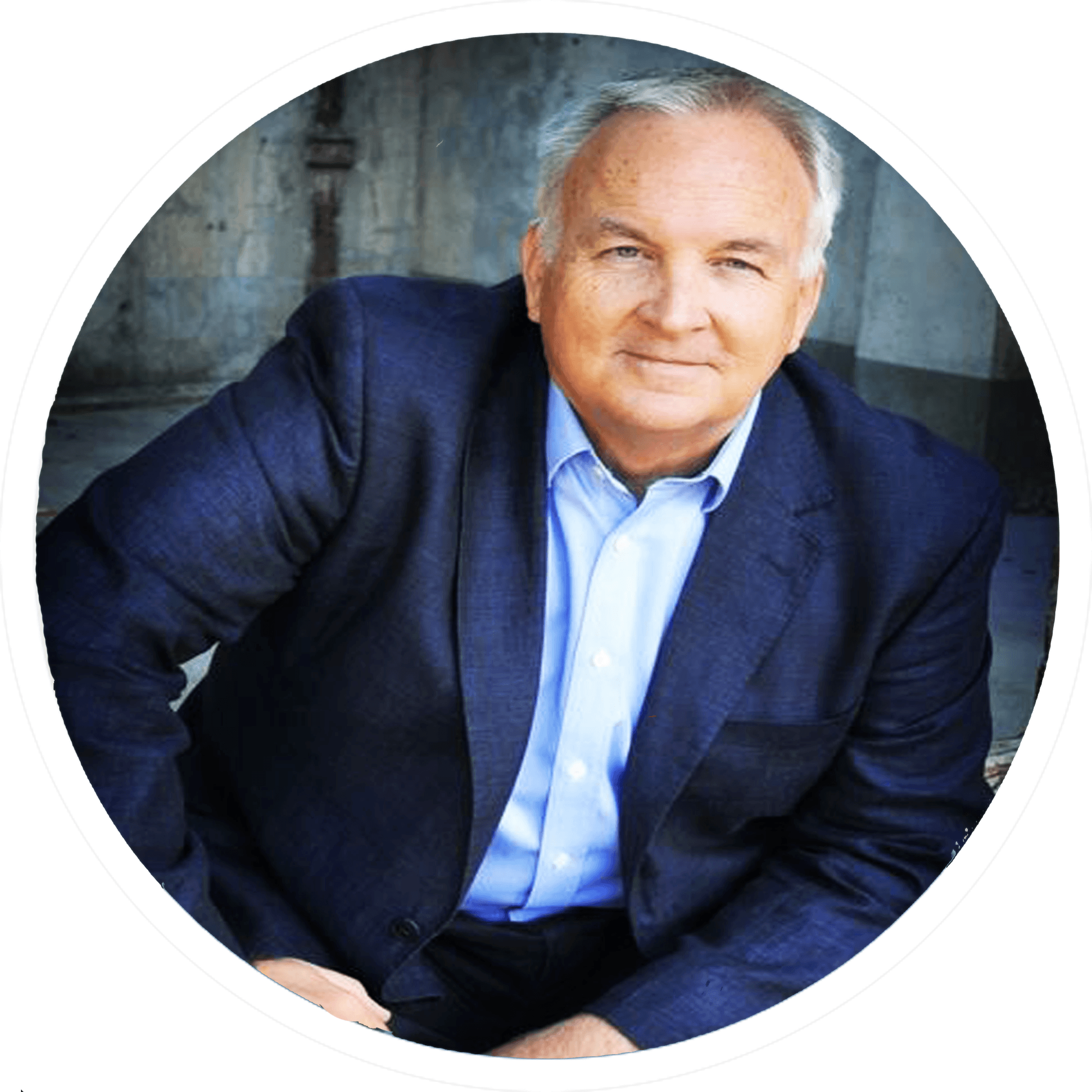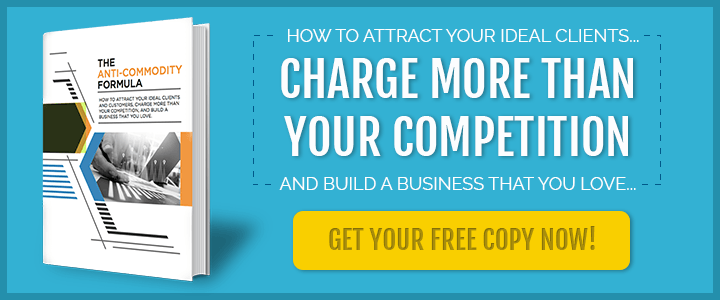Listen to this Podcast:
Listen on Anchor Listen on Spotify Listen on Apple Podcasts Listen on Google Podcasts
SUMMARY
- What does wealth mean to you? For The No Pants Project founder Mike Shreeve, wealth is not the Lamborghini (or other fancy things), because once you have a Lamborghini, that’s money you don’t have anymore; it’s in the car. Wealth is not financial freedom either, which is doing whatever you want because you have enough money. Rather, financial wealth is financial security.
- You can have financial freedom and still be subject to ups and downs where you are stressed out about money, because financial freedom is often a distraction from setting up a baseline financial system that will enable you to avoid the feast or famine cycle in business or freelancing.
- Think about money as a tool for taking care of the people that you love. Wealth is not about money accumulation, but how useful the money that you have is.
- The problem with using the money in your bank account as an indicator of wealth is that lump sums of money hardly solve any major difficulty. Say for example, you get in a car accident. While you might be able to pay for your hospital bills, therapy, and whatnot, there’s a big chance you won’t be able to work as much or continue running your business like you did before after you come home from all of that.
- True wealth is not the money in your bank account, but the assets that you’ve built and what they are doing for you and the people that you love. True wealth is having a consistent, repeatable source of income that will take care of everything even if something bad happens to you and you couldn’t work ever again.
- Wealth Equation #1: Number of Offers = Income
Increase your offers by automating them as much as possible, so that you can make sales without having to show up. Webinars, static sales pages, and email automations are just a few ways to automate your offers. - Wealth Equation #2: 70/30 Passive/Active
Seventy percent of your business revenue should be passive or scaled, i.e., income generated with you doing zero to very little work. Coaching and group consultations are examples of passive or scaled income.
Thirty percent of your revenue should come from high-ticket products or a profit center. These are the things that you enjoy doing the most while providing the most value to your clients.
The 30 percent active income is capped by what the market is willing to pay, but the 70 percent passive income has zero cap. - Wealth Equation #3: 40/20/40
For every dollar that comes out of your business and into your pocket, set aside 40 percent for taxes, 20 percent for investments, and 40 percent to live off of. - Recommended topic: the Profit First system.
- If you focus on growing your 20 percent in investments, it can eventually replace all of the income you generate from Wealth Equations #1 and 2.
- Three types of investments:
- Passive – stocks, business/angel investing, bonds
- Active – partnering in a business, real estate
- Income-related – hiring people, training yourself, advertising
HOT NEWS & DEALS
- Free Training! The No Pants Workshop
For anyone serious about owning their own successful (yet flexible) business. Learn how to quit your job and leverage your talents to live the ultimate freelancer freedom lifestyle! Register now for this free training to learn the 3-step plan to Full-Time (Profitable) Freelancing. - Free Client-Getting Email Templates For Freelancer Writers!
If you are a freelance writer (or you’d like to be!), download these FREE client-getting email templates. Mike has used these EXACT templates to land monthly retainers for his writing services, get featured in top shelf magazines (as a nobody), and land some of the biggest names in his dream industry as clients without spending a penny in advertising or marketing… - Download ‘The Anti-Commodity Formula’ Workbook!
Learn how to attract your ideal clients and customers, charge more than your competition, and build a business from a home that you love.
INSPIRATIONAL QUOTES
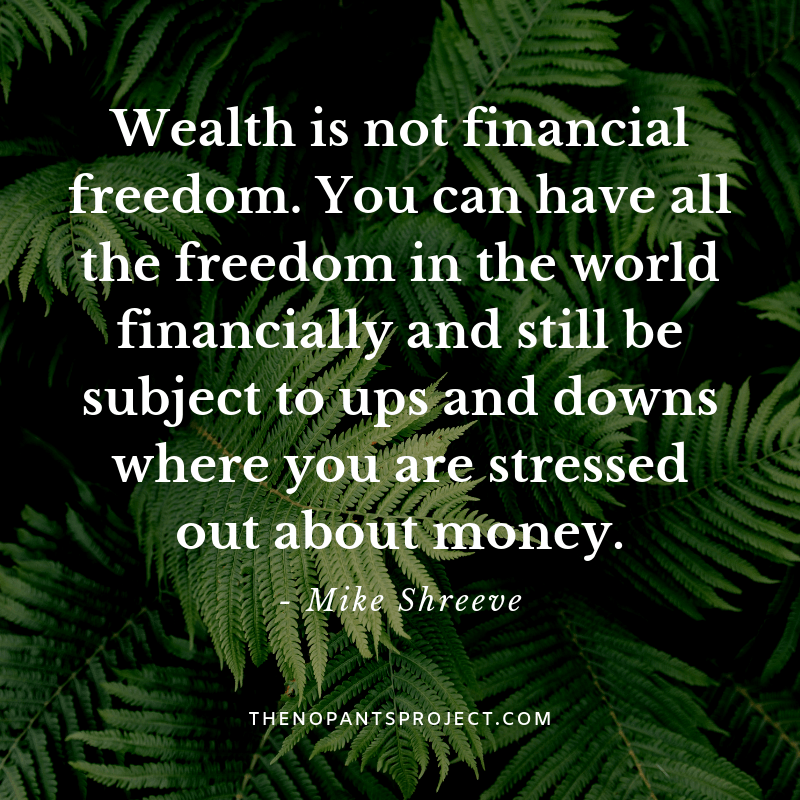
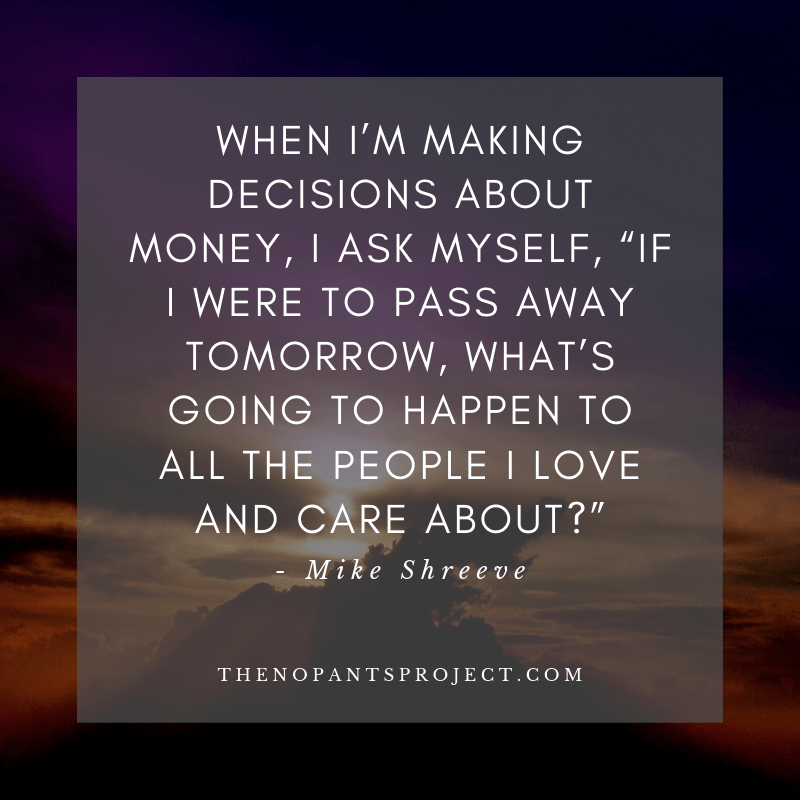
FULL TRANSCRIPT: 3 Equations That Create True Freedom
Hey everybody, Mike Shreeve here, founder and head troublemaker of The No Pants Project. You are watching a video, which we’re going to be talking about the three wealth equations.
Now, it’s very, very important before we dive in that we talk a little bit about what I mean by wealth, what I mean by equations, and to dispel any myths that might be surrounding this idea of orienting yourself towards the accumulation of money.
The first thing that I want to talk about is wealth itself.
Now to me, wealth is not the Lamborghini, it’s not the mansion, it’s not the fancy things. Because if you really think about it, once you have a Lamborghini, that’s money you don’t have any more. It’s now in the car. To me wealth is not even financial freedom.
Financial freedom is I have enough money, I can do what I want, go where I want, hang out with whoever I want.
To me financial wealth is financial security, because you can have all the freedom in the world financially and still be subject to ups and downs where you are stressed out about money.
Because typically, financial freedom, that lifestyle of I’m going to spend money whenever I want, I’m going to go wherever I want, I’m going to do whatever I want, that often is a distraction from setting up a baseline financial system or baseline financial story where what often happens is, especially if you’re a freelancer, you will have three or four good months and then you’ll have six bad months, and because you focused on financial freedom rather than financial security, those bad months are really, really bad.
So to me wealth is ultimately about how much security do I have financially.
Specifically the question that I ask myself when I’m considering wealth and building wealth and making decisions about money is, “if I were to pass away tomorrow, all the people I love and care about, what’s going to happen to them?”
What you realize when you frame it that way, instead of how many toys can I get, even how many vacations can I have, when you think about money as a tool for taking care of the people that you love, then one of the things that you realize is that wealth is not about money accumulation. It’s about how useful the money is that you have.
For example, one of the things that most people as they’re trying to develop some sense of security or some sense of financial independence is they say, “I am as wealthy as,” or, “I’m going to use how much money I have in my bank account as the indicator of how well I’m doing financially.“ The problem with that idea is that lump sums of money hardly ever solve any major problem.
For example, let’s say that you have $25,000 in the bank account. Something bad happens and you say to yourself, “Oh, it’s okay. I have $25,000.“ Okay, well fine, take $25,000, solve that problem.
But for every problem that happens, there’s always subsequent consequences that occur as a natural byproduct of that problem.
For example, let’s say that you get in a car accident and you’re hospitalized and you’re out of work for three months. You say, “Well, I’ve got $25,000 saved up. That’ll pay for my bills, that’ll pay for emergency, that’ll pay for all the problems and therapy and whatever.“ And you’re in the hospital and out of the hospital, getting rehab, all these different things, and you say, “Okay, I’ve got 25 grand. That’s going to cover all that.”
It may. It might. I mean, whatever happens, you may be even more expensive than what you have in the bank account.
But what’s even more important to understand is that when you come home from all of that, are you going to be able to return to the old ways? Are you going to be able to work as much? Are you going to be able to continue to run your business? Are you going to …
Life typically changes after major events. So that big chunk of change, which you were just going to throw at the problem, now all of a sudden it’s gone and you’re still really back to square one.
To me, and we’re going to be talking about these wealth equations here and how these wealth equations will build, what to me is true wealth, which is instead of focusing on a lump sum of money in my bank account, I look at what are the assets that I’ve built and what are they doing for me and the people that I love.
To me, true wealth is if something bad happened to me, yeah, maybe we do or don’t have money in the bank account, but we have enough of a financial system, a repeatable source of income and money that’s coming in consistently so that if something bad happened to me and I couldn’t work ever again, not just I couldn’t work for three weeks, but I couldn’t work for ever again, I have systems in place that will take care of all of that for me.
So that’s my definition of wealth.
I also believe that there’s really no reason to ever cap how high that goes.
It’s really just sort of an issue of sacrifice, how much are you willing to work and build and how disciplined can you be to get to that level.
I’m going to teach you the wealth that or at least the processes that I followed to build what I believe is wealth and my definition of it.
The first thing that we want to talk about, we actually talked about in another podcast episode, it’s called the three, or sorry, the three questions or seven questions to ask to grow your business.
1. The Number of Offers You Make = Income
Basically the wealth equation equals number of offers equals income.
As a business owner, and hopefully you guys can see that if you’re watching us on YouTube or any of the video channels, basically it’s a simple wealth equation.
I dive way deeper into it in another podcast. So go check that out. But it’s essentially if you are struggling with your current income that’s coming in, how many offers are you able to make?
What I will say in terms of wealth is that the adjustment to the equation is how many offers do you have automated.
Let me give you an example.
For The No Pants Project, which is for me an income stream that is about building wealth, again, not building a ton of money that rainmaking and buying Lamborghinis, but to build a business that can operate owner independent, a business that can generate income even if I don’t necessarily have to show up to work every day.
We have several offers. One of them is our coaching program. We have writing offers. All different offers in the business. Our goal as a company, as The No Pants Project is always, how do I automate it? How do I make it so that I don’t have to show up in order for this to work?
So as I’m growing my team right now, the main focus that I have is how can I build people and systems in my business and in my team that will allow me to increase the number of offers that I make?
Again, go listen to that podcast episode. It’s a very recent one. It’s probably like episode around the 40s, three or seven questions to grow your business or to double your income or something like that. Maybe we’ll link to it somewhere around here.
Increase this number.
So make sure that we have more offers seen by more people. And then how do we automate that? We do that with things like webinars. We do it with static sales pages, email automations. There’s a lot of things that you can do today where you don’t have to show up to make sales. That’s ultimately step number one of the wealth equation.
Why is that step number one of the wealth equation?
Well, because as this number goes up, so does your income. We’re really focusing on increasing the income.
2. Finding the 70/30 Passive/Active Balance
Second is another way to think about increasing the income is within the business itself, within your offers. If our marketing strategy in building wealth is to increase the number of offers, and to do so through as much automation as we possibly can, then the offers when breaking that down and looking at, okay, what is this going to do for us, is all about this very, very simple equation. I call it the 70/30 and it’s passive and active.
70% – Passive Income
The 70/30 passive/active concept framework, whatever you want to call it, basically 70% of the income that you make in your business, whether you’re a freelancer or a service provider or you sell widgets online, doesn’t matter, 70% of the revenue that comes into your business should be passive.
Another way to say that is scaled because passive I think these days is kind of gotten a bad name.
Essentially scaled means if you make $100,000 a year in your business, $70,000 of that $100,000 revenue per year ought to come from revenue which is generated without you having to do any of the work, or at the very least, very little work for that to happen.
For example, if you’re very good at social media, you provide social media for clients and you don’t have a coaching option or you don’t have an option where people can, 10 or 15 people can sign up to hear from you in a Q&A or in a group consult situation, then essentially you’re capping your income.
Now, the reason that I say you’re capping your income is because let’s say that you increase your offers, increase your offers, and it’s all automated, and soon you realize, “Well, all I have to do then is just pour money into advertising campaigns or pour money into content or just create more content. And as I do that, the offers will increase.” All of a sudden, if you’re a freelancer and a service provider, all of a sudden more people want your services than you can handle, and you keep raising your price and they still want and still and still want.
Well, you’re literally leaving a significant amount of money on the table if you don’t have this passive or scaled option. If you don’t have an option for people who can’t afford your full done-for-you service, if you don’t have an option for people who just maybe don’t want you to do it, they just want to learn about it, or they’re control freaks. Like I admit it.
Sometimes I’m a control freak and I’d rather just learn about it than necessarily hiring someone and having to go through that whole process. If you aren’t offering something that allows people to take advantage of that piece of you, then you will always be capped on your income because there’s only so many hours in a day, and at some point, you can keep raising your prices and keep raising your prices, but at some point the market’s just not going to be able to handle the price increase anymore.
So 70% passive scale, lots of different options.
30% Active Income
If you go to thenopantsproject.com you can talk to one of our people and they can help you sort of walk through where you should be in all of this and what kind of options there are for all sorts of different things.
If you then look at the 30%, so this 30% is really what I consider sort of high ticket, I think a lot of people call, but really what I would consider a profit center within your business.
In The No Pants Project coaching program, we call these your desserts. They can also be your main courses. But essentially it’s the most fun you can possibly have doing something for a client that also brings the most value to them.
For example, for me, one of the things that I do in my freelancing business is I have a program, really a profit center where I spend this 30% of my time working on helping public speakers and people who’ve written books add $1 million a year in additional revenue by helping them to take their ideas and package them into programs and then sell those programs online. I love that stuff. I love getting paid to do it.
When I was working with Mel Robbins, one of the great things about working with Mel was I literally got paid to just learn from her and go through all of her stuff and just be around her literally like at her house and all this cool stuff. So I love doing this 30% of my business. It also represents a significant amount of income.
Now, I want to talk about this very, very briefly in terms of building wealth. This is capped by what the market is willing to pay.
This manual labor type stuff, profit center. You may be a top 1% provider, and in that 1% you may be charging obscene amounts of money. When I do my freelancing, I have a minimum of $8,000 a month is the least I will work for anyone anymore.
Six figures per year retainer, minimum of a year long contract.
That’s a lot of money for one client. But that’s about the top end of what a lot of my clientele are willing to pay, so I can’t keep raising prices.
Now if all I did was that, that means that I would be stuck. What I want to do then is once I’ve kind of gotten to a point in my business where I focused on developing superpowers that allow me to create value for people, I’ll then shift my attention and focus and worry and stress.
For the first part of my business, I’ll figure out how can I get clients for this thing that I want to sell, for this, the profit center, the thing I love doing.
But then once I got that going, then it’s time to shift and start focusing on this 70% because what’s going to happen with the 70% is it has zero cap.
Meaning you could make $1 million a month from the scale, the passive income, if that was, you’re able to focus and do it and build the team that’s required.
I’m not saying it’s easy and you snap your fingers and make $1 million a month, but that … you would be far from the first person who’s ever figured out how to do that.
In terms of building wealth, we’re not just talking about here’s some fancy things to do. I’m giving you the step-by-step in terms of areas of focus as you grow your business.
Recap:
-
Step One
Step one, you’ve got to get offers out there. You’ve got to increase the number of offers. And you’ve got to automate that process. Because that, you have five sick days in a row. If your process for getting clients isn’t automated, you’re in trouble. Your income goes down.
-
Step Two
Number two is finding the 70/30 passive/active balance.
Once you’ve got this going, you’re starting to get clients, they’re coming in, you’re getting this 30%, you’re playing with price, you’re increasing price, then at seven then you start to focus on the 70%.
Now once you have this locked down, and this could take, just depends on how long it’s going to take. It could take you a year to get here. It could take you five years to get here. Some people wait a really, really long time. I’ll tell you. I waited too long to work on my passive income, my scaled income. And frankly it’s because I had a lot of fun.
I had a lot of fun in my profit center, and at the time, this was before I had kids, so I hadn’t quite put two and two together that wealth is important if I want to take care of them. And that ultimately, to me, wealth is important because right now I’m sacrificing time from my kids to run my business. So I need to make it worthwhile.
I would hate to be one of those people who at the end of their life passes away and all the money that they sacrificed their time to get is gone. I’m not saying work for money, but I’m saying if you’re going to work, be smart with your money so that it can at least be all that work and effort and time and all the hours that you put into generating income, that it actually has some value for you later on.
3. 40/20/40
Number three, or more importantly, value for others. Here’s the last one. This is the third wealth equation and this one is really, really important. Let me see if I can break this down.
This is the equation of your business, how the business generates sort of the makeup of the revenue that it generates, where, the sources that it comes from. This is then what you do with that revenue.
Number three is a what I … I just do, the rule that I do is 40/20/40.
Not to be confused with the 40/40/20 rule of Ed Mayer, which is about direct response marketing, but this is the 40/20/40.
Here’s what happens. Every dollar that comes out of my business into my pocket. This isn’t necessarily the inner workings of the business itself.
This is my take home from the business, I take 40% and set it aside for taxes. You guys see that down there? Okay
- 40%, set aside for taxes.
- I take 20% and set aside for investments. We’ll talk about those investments in a second.
- And then I take 40% to live off of. Have fun, do my vacations, do all that kind of stuff.
Now there’s a … Maybe some day I’ll do a video on what I do with this 40% and how I … There’s a really cool system called profit first. Go google profit first. It’s a really, really cool financial system as well. But this is what I do for my sort of macro budgeting.
Now, I know in the United States the word budgeting has a bad connotation and a bad word, but what I want to show you is if you internalize this mathematical equation, 40/20/40, and then grow this piece right here, this 20%, eventually this 20% in investments will replace all of this business income.
I’m going to show you and talk very briefly about how that’s going to happen for you if you do it. It’s not going to happen overnight. Oh my gosh.
This is going to take a while. I’ve been doing this for 10 years. I’m not quite there yet. But I’m still working on it and I see how it’s going to get me there.
40% for taxes. Just don’t, just pay your taxes, man. Don’t mess with those guys. Give them what they want. It is what it is. Deal with it. That’s part of the course, part of the deal.
Now this investment, in my opinion, there’s three types of investments. I’m actually going to pop up this over and we’ll talk about the three types of investments. So three types of investments.
3 Types of Investments
- First, the first type of investment is what I would call passive.
- The second is active.
- And the third is, I call it, I just call it income personally.
And we’ll talk about what that means.
Let’s say you get $10,000 a month from your business. Four grand goes straight to taxes, just put it away, let your accountant deal with it. And that’s good.
$2,000 a month goes into an investment account, which you then distribute amongst these three types of investments as you see fit.
-
Passive investments
Number one, passive investment. That’s something like stocks or something like investing in a business, so somebody else’s business. So maybe like angel investor.
In other words, this is literally, you just put money somewhere and, shoot, bonds even.
This is literally, you just take money, you put it somewhere, and it grows. You don’t really have to manage it. You don’t have to deal with it. Maybe you have somebody else who is managing, somebody else who is dealing with it, and you literally just check your accounts.
The problem with passive investments is that the risk is really high. See if you can see that arrow there?
Risk is really high in passive investments. Frankly, that makes sense. You’re not really adding value. You’re just putting money out there and somehow growing. We can talk all about all that kind of stuff.
But passive investments, high risk, rewards are also to be frank, not. I mean sure, you have your occasional home run, but the rewards … Bonds aren’t going to make you rich. But it’s passive. You don’t have to do anything.
-
Active Investment
An active investment might be something like maybe you’re a partner in a business and your role is to bring money and ideas. This is different than angel investing.
Look, I understand that there’s all sorts of levels of angel investing. In my mind, angel investing is, “Here you go Silicon Valley person, here’s $1 million. See you later.”
Partnering though is a more active investment role. Maybe you serve on the board. You put some money in. Maybe you partner with somebody who has some stuff.
You advise, you show up for like a phone call a week or something. I have a few of these deals. I put money in. I advise the people. They grow it. I get a cut.
Another one is real estate. This could be house flipping. This could be buying houses, renting them out. This could be Airbnb.
I think a lot of people think that real estate is a passive investment. I would say unless you’re getting into something like going to Grant Cardone and whatever, I think it’s like a minimum $5,000 investment into his big fund, which pays you out like, I don’t even know. It’s like really low. It’s like barely above inflation.
Real estate is actually active because it’s an asset that you have to improve. You have to deal with tenants. Even if you have a management company, there’s still things. You have to take care of it. You have to be concerned about it. You have to worry about it. There’s mental energy, even if it’s not physical work, in order to maintain the investment that you’ve created.
Now, the cool thing about this is that the risk is lower. It’s not the lowest form of risk, but it is lower.
There is of course you could over leverage in real estate. You could get a bad partnership. There are things that can go wrong. But because you have more control in these active investments, you’re able to at least have an influence in how things play out, which is not the same as investing in stocks. You invest in stocks. You’re at the mercy of the market.
-
Income Related Investment
Last is what I call income, income investment or income related investment.
Now, this is where you invest in either your business, so that could be hiring someone. It could be training yourself. It could be investing in advertising. It could be investing in a lot of different things.
But essentially, now you may be saying, “But Mike, shouldn’t I already be doing that within my business?” I’m saying yes, but what I’m suggesting is that you take $2,000 a month of your own personal money that you were going to pay yourself, that you were going to go blow on something that didn’t mean anything anyways, and go spend that in your own business.
Ultimately what we’re talking about is a mindset. And the mindset is to look at your own business and say, am I investing in it heavily enough, or am I just trying to take money so I can keep it in an account somewhere for a “rainy day” understanding that when the rainy day comes, having someone in your business that will keep the business running, even if you’re sick or you have to take off for four weeks or something like that, is a way better use of that $2,000 than tucking the $2,000 under a cushion somewhere.
Same with training. Maybe right now as a freelancer, you’re only able to charge $45 an hour. If you take that $2,000 a month that you are going to pay, I don’t know, for something silly to buy a new car or whatever that you don’t necessarily need or just to stick it in a mattress somewhere, if you were to invest that training in yourself, you could go from $45 an hour, get a good mentor, get a good coach. All of a sudden you’re doing $250 an hour. 10 hours later you’ve made the $2,500 back. Not only have you made that $2,000 back after billing 10 hours at $250 an hour. You now can bill $250 an hour in perpetuity, into the future. And then same again with advertising and things like that.
This is how I view investments. Let me talk about sort of where, at least in my opinion, how I’ve generated the wealth that I do have and relatively young and how I’ve done it in frankly not a stressful way.
It’s been rather relaxing to be honest, in that the more financially secure I get, the more options are open up to me and I can take a breath every once in a while.
First, when I very first started, it was 100% into the income producing investments. Every spare dollar. I mean I did way more than 20% of my income from my business. Basically every spare dollar I could handle, I put into income producing. I hired mentors. I hired coaches. I bought books. I bought programs. I did things like spent my own money on advertising so that I could learn firsthand instead of just from a course, connecting with people, everything I could do.
Nowadays, this isn’t 90 because I have in a lot of ways reached what you could consider knowledge plateaus in terms of I have more knowledge than I’m currently executing, so I need to focus on executing. I’m definitely doubling down on hiring. Definitely doubling down on hiring. And I’ve moved a big percentage into active investments into both real estate and in partnering.
I am building, taking that 20% and working it now into this. We’ll actually, I want to … We’ll go back and talk about 20%. I don’t do 20% anymore. I actually do more and we’ll talk about that in a second.
And then lastly, I’ll tell you the truth. I hardly ever put anything into passive. Why? Because if I were to look at what it takes to do well in stocks versus what it takes for me to do well as a partner or what it takes for me to do well in real estate, I get a significantly higher return on this active investment.
Now, I will tell you, my goal someday and hopefully in 5, 10 years I’ll be making a video that talks about how I did this, but my goal, my vision anyways is to get this income that I do from my freelancing, from The No Pants, from my fiction business to get this income high enough that I can roll 90% of my monthly income into my active investments.
Again, I’ll talk about why I went from 20 to 90, but I’m going to try and get 90% into my active investments and continue to build up the real estate and the partners until I can take the active investments and pour literally 40% of the money I make from my active investments into passive so that the following will occur.
So that I don’t have to do this anymore. So that basically my active investments have entirely replaced my income production, and we’ll talk about that in a second, and instead now my active investments, so I’m now making my living off of my investments, are now turning into and producing their own sub investments by investing in passive.
We’ll see. I know lots of people who’ve done it. I’m a part of several masterminds where they have done it.
Again, that’s why I do these masterminds, so I can be by people who’ve already done what I want to do. But we’ll see. I mean there’s a lot of variables and life is unpredictable. But what I do know is that as I continue to move in this direction, I do become more and more financially secure.
Here’s this piece here now I want to talk about. So 40% for taxes, 20% for investments, 40% to live off of.
Now what happens with most people is they increase their overall income, but they don’t change these numbers.
In other words, as their income increases, their lifestyle costs increase as well. They do take more expensive vacations. They do go do these more fancy things. They do all these … They spend the money that they make. It’s one of those silly things, sort of like Parkinson’s law.
Parkinson’s law says basically any project fills the time it’s allotted. I’m sure that somebody smarter than me has already given a name to this concept, but it’s basically how much money you have is how much money you spend. A lot of people do that.
They just keep this 40%. They continue to put away investments and donations and things like that. Pay off the 40% taxes. And that’s what they do.
Now the problem with that is they’re missing out on really easy financial security winds that they could take advantage of specifically, instead of increasing how much it costs for you to live, increase how much you invest. Let me break that down for you for a second.
Let’s say we got $10,000 a month coming in. We say, “Okay, four grand to taxes, 2000 to investments, four grand to myself.”
Now most people, if they went from $10,000 a month, all of a sudden their business is doing $20,000 a month, they’d say, “Okay, $8,000 to taxes, 4,000 to investments. And now I get to play with eight grand.” What my wife and I are doing, and we could be wrong, I’m not saying this is the guaranteed solution, but so far the payoffs have been what we are looking for as a family.
Instead of saying, “Okay, now it’s 40/20/40,” we actually change this from 40 because that number is not going to change to 40 to 20. In other words, we do 40% taxes, 40% investments, 20% to live off of. And you say, well why is that?
Because if you do these numbers on 20,000, listen to this, 20 grand, eight goes to taxes. Now eight goes to investments. And we live off of four, which is exactly what we were living off of before. We maintain a lifestyle.
I mean, I’ll be truthful with you. The things we love to do are road trips, reading books, watching movies, and going on walks. That is what legitimately makes us super happy.
I feel very fortunate to have married someone and to have kids who all enjoy relatively inexpensive pleasures in life. We don’t go out and blow money on really anything. We keep our expenses low and all this extra money that we’re making all of a sudden, instead of building our lifestyle up to fit the new 40%, we adjust these percentages so that we can increase the investments that we are making here.
Now to go back to the, let’s see here, the equation, just as a really quick recap and review, number one, the first equation which we’ve done another podcast episode on, is all about increasing your offers that you can increase your income.
Number two is the 70/30 passive/active. Make sure that you automate those offers by the way. 70% of your business revenues should be passive or scaled income. 30% should be the sort of hands-on done-for-you, done-with-you type of thing.
And then number three is the 40/20/40 which is how you then invest this money appropriately to create what in my opinion is wealth, which is financial security.
Now that pretty much wraps up what we have here.
I can tell you one of the things that The No Pants Project does and we were very … we have gotten very good at it and we continually improve ourselves as I personally take this 20% on investment and hire people and train myself to be better at delivering results.
But what we do in The No Pants Project is we focus on wealth equation number one and two. That’s what we help people do.
- We help you create offers.
- We help you build offers.
- We help you to automate the offer, like making those offers, in other words, getting in front of people so that you can increase your income.
- And then we also are very good at helping people to build the 70/30 passive/active balance so that you can continue to increase income and then up to you to do the rest, up to you to figure out the investments.
I might do future videos and more financial education, things like that. It’s very strange to me that more people don’t know about this. And what I think is going on is basically before, the past 10 or 15 years, in order for you to know about this stuff, you had to actually personally know somebody who was really rich. Most rich people are super busy and most rich people try to get with other rich people to share ideas and exchange stuff like that.
So really, until very recently when people are more open. More books are being published now than ever before. Thousands of hours of YouTube videos are being put up every second basically. And some of them are people who are willing to share coaching programs, mentored. There’s more, we have more access now than ever before to this information.
And I’m really, really excited and fascinated and super jazzed about the future to see what happens as more and more people realize that this is really simple and it’s very doable.
It requires discipline.
It requires that horrible word that everybody hates called budget. But if you do it, it’s … I don’t want to say it’s foolproof because tomorrow the economy could collapse completely and real estate could be worthless and we could dip into a civil war.
Who knows what’s going to happen tomorrow.
You never want to try to predict the future. But it’s very hard to mess this up as long as you are building with these sort of guidelines in place.
Again, we’re very good at helping you with number one and two, creating offers, 70/30 passive/active.
If you’d like us to help you, that’s what we do.
Go to thenopantsproject.com. There’s a whole sort of process. You can talk to people. You can watch videos and webinars and all sorts of different things to figure out what is right for you.
All right, that’s it my friends. This is the three wealth equations.
Go check out the other podcast episode. We’ll link to it somewhere here about this first one. It is critical, increasing offers, increase income, and to automate as many of those as possible.
And I will talk to you in the next video.
